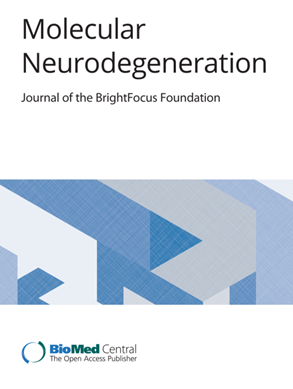ufmyation与阿尔茨海默病的许多联系:一项综合综述
IF 17.5
1区 医学
Q1 NEUROSCIENCES
引用次数: 0
摘要
阿尔茨海默病(AD)是一种复杂的神经退行性疾病,其特征是病理性tau和β -淀粉样蛋白的积累。ufmyation是一种新兴的泛素样翻译后修饰,对健康的大脑发育至关重要。UFM1级联最近被确定为体外和体内tau聚集的主要修饰因子。此外,死后AD大脑显示明显的ufmyation改变,这与病理性tau显著相关,表明UFM1可能确实是人类疾病的修饰因子。然而,AD与ufmyation之间的联系尚未得到充分探讨。有趣的是,已知ufmyation级联在阿尔茨海默病中已知改变的几种途径中发挥重要作用,如DNA损伤反应、内质网稳态、自噬和免疫反应。本文讨论了ufmyation与AD发病机制之间的许多联系,强调了ufmyation在这些通路中的作用及其在AD中的异常。了解这些联系对于阐明UFM1如何影响AD的分子机制以及发现针对ufmy化途径进行疾病修饰的新治疗策略非常重要。本文章由计算机程序翻译,如有差异,请以英文原文为准。
The many connections of UFMylation with Alzheimer’s disease: a comprehensive review
Alzheimer’s disease (AD) is a complex neurodegenerative disorder that is characterized by the accumulation of pathologic tau and beta-amyloid proteins. UFMylation is an emerging ubiquitin-like post-translational modification that is crucial for healthy brain development. The UFM1 cascade was recently identified as a major modifier of tau aggregation in vitro and in vivo. Moreover, post-mortem AD brain shows pronounced alterations of UFMylation that are significantly associated with pathological tau, suggesting UFM1 might indeed be a modifier of human disease. However, the link between AD and UFMylation is yet to be fully explored. Interestingly, the UFMylation cascade is known to play important roles for several pathways that are known to be altered in AD, such as the DNA damage response, ER homeostasis, autophagy and the immune response. This review discusses the many connections between UFMylation with AD pathogenesis, emphasizing the role of UFMylation in these pathways and their abnormalities in AD. Understanding these connections is important to elucidate molecular mechanisms how UFM1 may impact AD and to uncover novel therapeutic strategies targeting UFMylation pathways for disease modification.
求助全文
通过发布文献求助,成功后即可免费获取论文全文。
去求助
来源期刊

Molecular Neurodegeneration
医学-神经科学
CiteScore
23.00
自引率
4.60%
发文量
78
审稿时长
6-12 weeks
期刊介绍:
Molecular Neurodegeneration, an open-access, peer-reviewed journal, comprehensively covers neurodegeneration research at the molecular and cellular levels.
Neurodegenerative diseases, such as Alzheimer's, Parkinson's, Huntington's, and prion diseases, fall under its purview. These disorders, often linked to advanced aging and characterized by varying degrees of dementia, pose a significant public health concern with the growing aging population. Recent strides in understanding the molecular and cellular mechanisms of these neurodegenerative disorders offer valuable insights into their pathogenesis.
 求助内容:
求助内容: 应助结果提醒方式:
应助结果提醒方式:


